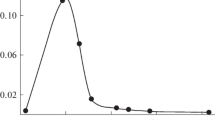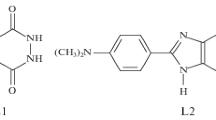Abstract
We have studied the interaction of 3-nitrotyrosine with peroxynitrite using three different methods; chemiluminescence, spectrophotometry and HPLC. Peroxynitrite-induced luminol or lucigenin chemiluminescence were significantly decreased by 3-nitrotyrosine, in concentration-dependent manners. The intensity of the peroxynitrite spectrum was also markedly reduced in the presence of 3-nitrotyrosine in the spectrophometric assay. However, there was no attenuation of the 3-nitrotyrosine signal in the HPLC assay after mixing with peroxynitrite. The interaction of 3-nitrotyrosine and hypochlorous acid (HOCI) was also studiedvia the chemiluminescence assay, where the HOCI-induced responses were markedly inhibited by 3-nitrotyrosine. These results suggest that caution should be taken when studying the levels or interactions of 3-nitrotyrosine.
Similar content being viewed by others
References
Banks, B. A., Ischiropoulos, H., McClelland. M., Ballard, P. L., and Ballard, R. A., Plasma 3-nitrotyrosine is elevated in premature infants who develop bronchopulmonary dysplasia.Pediatrics, 101, 870–874 (1998).
Beckman, J. and Crow, J., Pathological implications of nitric oxide, superoxide and peroxynitrite formation.Biochem. Society Trans., 21, 330–334 (1993).
Beckman, J. S., Beckman, T. W., and Chen, J., Apparent hydroxyl radical production by peroxynitrite: implications for endothelial injury from nitric oxide and superoxide.Proc. Natl. Acad. Sci., 87, 1620–1624 (1990).
Beckman, J. S., Chen, J., and Ischiropoulos, H., Oxidative chemistry of peroxynitrite.Methods Enzymol., 233, 229–240 (1994).
Crow, J. P. and Ischiropoulos, H., Detection and quantitation of nitrotyrosine residues in proteins:in vivo marker of peroxynitrite.Methods Enzymol., 269, 185–194 (1996).
Crowley, J. R., Yarasheski, K., Leeuwenburgh, C., Turk, J., and Heinecke, J. W., Isotope dilution mass spectrometric quantification of 3-nitrotyrosine in proteins and tissues is facilitated by reduction to 3-aminotyrosine.Anal. Biochem., 259, 127–135 (1998).
Duncan, M. W., A review of approaches to the analysis of 3-nitrotyrosine.Amino Acids, 25, 351–361 (2003).
Frost, M. T., Halliwell, B., and Moore, K. P., Analysis of free and proteinbound nitrotyrosine in human plasma by a gas chromatography=mass spectrometry method that avoids nitration artifacts.Biochem. J., 345 Pt 3, 453–458 (2000).
Fukuyama N., Takebayashi, Y., Hida, M., Ishida, H., Ichimori, K., and Nakazawa, H., Clinical evidence of peroxynitrite formation in chronic renal failure patients with septic shock.Free Radio. Biol. Med., 22, 771–774 (1997).
Gaut, J. P., Byun, J., Tran, H. D., and Heinecke, J. W., Artifact-free quantification of free 3-chlorotyrosine, 3-bromotyrosine, and 3-nitrotyrosine in human plasma by electron capture-negative chemical ionization gas chromatography mass spectrometry and liquid chromatographyelectrospray ionization tandem mass spectrometry.Anal. Biochem., 300, 252–259 (2002).
Gow, A., Duran, D., and Thorn, S. R., Carbon dioxide enhancement of peroxynitrite-mediated protein tyrosine nitration.Arch. Biochem. Biophys., 333, 42–48 (1996).
Ischiropoulos, H., Biological tyrosine nitration: a pathophysiological function of nitric oxide and reactive oxygen species.Arch. Biochem. Biophys., 356, 1–11 (1998).
Ischiropoulos, H., Zhu, L., and Chen, J., Peroxynitrite-mediated tyrosine nitration catalyzed by superoxide dismutase.Arch. Biochem. Biophys., 298, 431–437 (1992).
Jiang, H. and Balazy, M., Detection of 3-nitrotyrosine in human platelets exposed to peroxynitrite by a new gas chromato-graphy-mass spectrometry assay.Nitric Oxide, 2, 350–359 (1998).
Kahraman, S. and Demiryurek A. T., Propofol is a peroxynitrite scavenger.Anesth. Analg., 84, 1127–1129 (1997).
Kamaisaki, Y., Wada, K., Nakamoto, K., Kishimoto, Y., Kitano, M., and Itoh, T., Sensitive determination of nitrotyrosine in human plasma by isocratic high-performance liquid chromatography. J.Chromatogr. B. Biomed. Appl., 685, 343–347 (1996).
Kohnen, S. L., Mouithys-Mickalad, A. A., Deby-Dupont, G. P., Deby, C. M., Hans, P., Lamy, M. L., and Noels, A. F., Investigation of the reaction of peroxynitrite with propofol at acid pH: predominant production of oxidized, nitrated, and halogenated derivatives.Nitric Oxide, 8(3), 170–181 (2003).
Kooy, N. W.and Lewis, S. J., Nitrotyrosine attenuates the hemodynamic effects of adrenoceptor agonistsin vivo: relevance to the pathophysiology of peroxynitrite.Eur. J. Pharmacol., 310, 155–161, (1996).
Morrissey, B., Schilling, K., Weil, J., Silkoff, P., and Romdan, D., Nitric oxide and protein nitration in the cystic fibrosis airway.Arch. Biochem. Biophys., 406, 33–39 (2002).
Mouithys-Mickalad, A., Hans, P., Deby-Dupont, G., Hoebeke, M., Deby, C., and Lamy, M., Propofol reacts with peroxynitrite to form a phenoxyl radical: demonstration by electron spin resonance.Biochem. Biophys. Res. Commun., 249, 833–837 (1998).
Mouithys-Mickalad, A. M., Zheng, S. X., Deby-Dupont, G. P., Deby, C. M., Lamy, M. M., Reginster, J. Y., and Henrotin, Y. E.,In vitro study of the antioxidant properties of non steroidal anti-inflammatory drugs by chemiluminescence and electron spin resonance (ESR).Free Radic. Res., 33(5), 607–621 (2000).
Oldreive, C., Bradley, N., Bruckdorfer, R., and Rice-Evans, C., Lack of influence of dietary nitrate=nitrite on plasma nitrotyrosine levels measured using a competitive inhibition of binding ELISA assay.Free Radic. Res., 35, 377–386 (2001).
Ohshima, H., Friesen, M., Brouet, I., and Bartsch, H., Nitrotyrosine as a new marker for endogenous nitrosation and nitration of proteins.Food Chem. Toxicol., 28, 647–652 (1990).
Pietraforte, D., Salzano, A.M., Marino, G., and Minetti, M., Peroxynitrite-dependent modifications of tyrosine residues in hemoglobin. Formation of tyrosyl radical(s) and 3-nitrotyrosine.Amino Acids, 25(3-4), 341–350 (2003).
Radi, R., Peluffo, G., and Alvarez, M. N., Unraveling peroxynitrite formation in biological systems.Free Radic. Biol. Med., 30, 463–488 (2001).
Reilly, P. M., Schiller, J., and Bulkley, G. B., Pharmacologic approach to tissue injury mediated by free radicals and other reactive oxygen metabolites.Am. J. Surgery, 16, 488–503 (1991).
ter Steege, J. C., Koster-Kamphuis, L., van Straaten, E. A., Forget, P. P., and Burman, W. A., Nitrotyrosine in plasma of celiac disease patients as detected by a new sandwich ELISA.Free Radic. Biol. Med., 25, 953–963, (1998).
Thiry, J. C., Hans, P., Deby-Dupont, G., Mouythis-Mickalad, A., Bonhomme, V., and Lamy, M., Propofol scavenges reactive oxygen species and inhibits the protein nitration induced by activated polymorphonuclear neutrophils.Eur. J. Pharmacol., 499, 29–33 (2004).
Valdez, L. B., Alvarez, S., Zaobornyj, T., and Boveris, A., Polyphenols and red wine as antioxidants against peroxynitrite and other oxidants.Biol. Res., 37(2), 279–286 (2004).
Van der Vliet, A., Eiserich, J. P., Kaur, H., Cross, C. E., and Halliwell, B., Nitrotyrosine as biomarker for reactive nitrogen species.Methods Enzymol., 269, 175–184 (1996).
Viera, L., Ye, Y. Z., Estevez, A. G., and Beckman, J. S., Immunohistochemical methods to detect nitrotyrosine.Methods Enzymol., 301, 373–381 (1999).
Vissers, M. C., Stern, A., Kuypers, F., Van den Berg, J., and Winterbourn, C. C., Membrane changes associated with lysis of red blood cells by hypochlorous acid.Free Radic. Biol. Med., 16, 703–712 (1994).
Whiteman, M. and Halliwell, B., Loss of 3-nitrotyrosine on exposure to hypochlorous acid: implications for the use of 3-nitrotyrosine as a bio-markerin vivo. Biochem. Biophys. Res. Commun., 258, 168–172 (1999).
Yildiz, G., Demiryürek, A.T., Sahin-Erdemli, I., and Kanzik, I., Comparison of antioxidant activities of aminoguanidine, methylguanidine and guanidine by luminol-enhanced chemiluminescence.Br. J. Pharmacol., 124, 905–910 (1998).
Author information
Authors and Affiliations
Corresponding author
Rights and permissions
About this article
Cite this article
Turan, N.N., Ark, M. & Demiryurek, A.T. Comparison of spectrophotometric, HPLC and chemilumines-cence methods for 3-nitrotyrosine and peroxynitrite interaction. Arch Pharm Res 28, 358–363 (2005). https://doi.org/10.1007/BF02977805
Received:
Issue Date:
DOI: https://doi.org/10.1007/BF02977805




